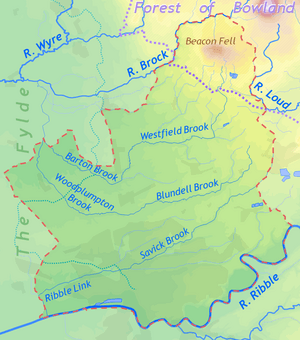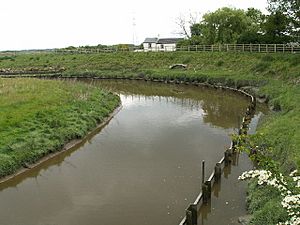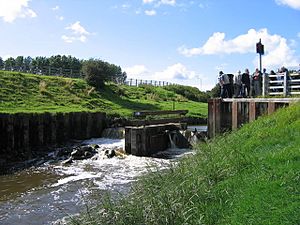Savick Brook facts for kids
Savick Brook is a small river in Lancashire, England. It starts near Longridge and flows west, passing north of Preston. Eventually, it joins the River Ribble.
Contents
Exploring Savick Brook's Journey
Savick Brook is like a smaller stream that feeds into the larger River Ribble. It begins its journey on the edge of Longridge, about 8 kilometers (5 miles) northeast of Preston. From there, it flows west through a part of Preston called Fulwood. It then turns sharply south near the village of Lea. The brook continues south until it meets the River Ribble. This meeting point is about 2.4 kilometers (1.5 miles) west of the entrance to Preston Dock.
What's Under the Ground?
Most of the land beneath Savick Brook is made of red sandstone rock. This rock is called Sherwood sandstone. Further east of Preston, there are older rocks called carboniferous rocks. The upper part of Savick Brook, near Longridge, flows over these carboniferous rocks. Much of the area is also covered by a type of clay left behind by glaciers, called boulder clay.
Smaller Streams Joining In
Several smaller streams flow into Savick Brook, adding to its water. These include:
- Deepdale Brook
- Eaves Brook
- Sandy Brook
- Sharoe Brook
The Ribble Link: A Canal Connection
Imagine connecting two waterways that were once separate! In December 2000, work began to turn a 6.4-kilometer (4-mile) part of Savick Brook into a navigation canal. This project is known as the Ribble Link. Its main goal was to connect the Lancaster Canal, which was previously cut off, to the River Ribble.
The Ribble Link opened in July 2002. It has nine special water elevators, called locks. These locks allow small boats and narrowboats to travel between the two waterways. Boats up to 18.8 meters (61.8 feet) long and 2.3 meters (7.5 feet) wide can use this link.
Monitoring Water Levels and Quality
There are special places along Savick Brook where people check the water level and take samples to see how clean the water is.
Water Level Checks
At the Savick Brook Monitoring Station, the water usually stays between 0.77 meters (2.5 feet) and 1.26 meters (4.1 feet deep). This is based on measurements taken over a long time. In one recent year, the water level was between 0.76 meters (2.5 feet) and 1.37 meters (4.5 feet) for at least 151 days.
Water Quality: Keeping the Brook Clean
In 2001, a group called the Environmental Agency checked the water quality. They found that some parts of the brook had poor water quality. This was often due to water from sewers. Because of this, a company called United Utilities promised to make improvements to the Preston Sewerage System. Their goal was to reduce pollution from sewer overflows and make the water cleaner.
Another study in 2012 by the Department for Environment, Food & Rural Affairs (Defra) also looked at the water quality. They found that the upper parts of the brook had moderate to bad biological quality. This means there weren't as many healthy living things in the water. The chemical quality was good for ammonia but poor for phosphate. In the lower parts of the brook, the biological quality was also moderate to bad. The chemical quality was mostly good, but sometimes poor for ammonia and moderate to poor for phosphate.
The study also noticed that the water quality got worse when it rained a lot. This was especially true further downstream. Between 2001 and 2011, there were fewer fish that like fast-flowing water, like barbel and chub. Defra believed that water from farms (especially dairy farms) and sewer discharges were the main reasons for this.
Fishing in Savick Brook
Sections of Savick Brook, especially where it meets the River Ribble, are popular spots for people who enjoy fishing. The 2001 Environmental Agency survey found that the brook's water was good enough for many types of fish to live and reproduce on their own. They found eleven different kinds of fish:
- barbel
- chub
- dace
- eel
- flounder (young fish)
- gudgeon
- minnow
- perch
- roach
- stickleback
- stoneloach
The survey was surprised to find so many fish in the brook. This was despite the risks of pollution from nearby farms and towns. It seems that the brook is especially good for chub. Also, young flounder, which are sea fish, use the brook as a safe place to grow up.
|




